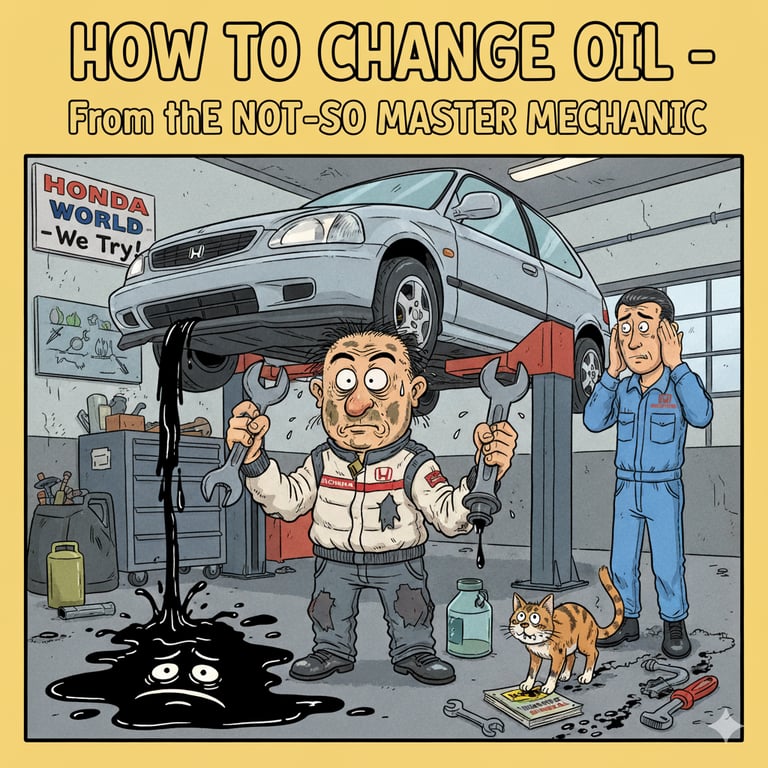How to Change Your Oil
Step-by-step process of changing your oil from the Not-So-Master Mechanic of the Honda World
GARAGE


How to Change Oil - from the Not-So-Master Mechanic of the Honda World
Presented by the Honda Club President
🛑 You can find images by clicking on the red-labeled text.
Let’s be honest—changing your oil on a gas-powered Honda isn’t rocket science. It’s more like glorified adult finger painting with hot sludge. But if you follow these steps, you’ll keep your Honda humming like it just rolled off the assembly line.
When to Change Your Oil
You should change your oil every 3,500–5,000 miles, or as recommended by your specific Honda model and the type of oil you use (synthetic or regular). Most Hondas from 2000 onward have an oil life indicator in the dash. When it dips below 20%, it’s time to act.
Pro tip: If your car sits more than it drives, change the oil at least once a year, regardless of the mileage.
Step-by-Step: Honda Club Style
Step 1: Prep the Scene
Park your car on a level, solid surface. Pop the hood. Set the parking brake like you mean it. Open the oil fill cap and set it aside. Pull out the oil dipstick and place it somewhere safe—and somewhere you’ll remember.
Step 2: Jack It Up
Grab a floor jack and locate a solid lifting point—usually behind the radiator. Lift the car until you can slide under with an oil catch pan and a healthy dose of optimism. Give yourself room to turn ratchets and contemplate your life choices.
Step 3: Safety First
Jack stands are your best friends. Before working under your vehicle, it is important to find appropriate jack stand points. Never place a jack stand on a suspension component, engine, or transmission, and never get under a vehicle supported by jack stands alone.
The following are common, strong points to place jack stands once you have safely lifted the vehicle with your floor jack:
Pinch Welds: Look along the side of the vehicle, under the doors, for the metal seam known as the pinch weld. You will find small, reinforced notches in this seam near each wheel well. These are the designated jack and jack stand points. You can also use a jack stand pad to prevent damage to the pinch welds.
Axle tubes (rear): The rear axle tubes, especially near the suspension mounting points, are very strong and can support the rear of the vehicle.
Place them under the driver and passenger sides near the front wheel wells. Yes, it takes extra time. Yes, it’s worth it. Honda Club bylaws strictly prohibit getting squished. To ensure the vehicle is stable and the jack stands are supporting the weight of the car, you can lower the floor jack slightly.
Step 4: Drain the Oil
Locate the drain bolt (usually 14mm–19mm). Use a ratchet or box-end wrench. Make sure it’s set to “lefty loosy.” If the bolt laughs at you, use a cheater bar or a hand sledge to break the torque. Once loose, reverse the bolt and be ready with an oil drip pan. Oil will hit your hands, your arm, and possibly your soul. Wear gloves. Bring rags. Paper towels. Bring a roll. Or three. Maybe a priest.
Step 5: Plug It Back
Once the oil has stopped draining out (it’s okay if it still trickles) and you’ve regained your dignity, inspect the drain plug. Check to make sure it’s not about to betray them mid-drive. Here's what to look for:
Cracks or Damage
* Look for any visible cracks, chips, or deformities in the metal.
* If it looks like it’s been through a simulation glitch or a medieval joust, replace it.
Stripped Threads
* The threads should be clean and well-defined—not flattened, cross-threaded, or chewed up.
* Damaged threads can lead to leaks or make it impossible to tighten properly.
Old Crush Washer
* If the washer is still clinging to the plug like a sad pancake, remove it.
* Replace with a fresh crush washer to ensure a proper seal.
* No washer = slow leak = shameful Club citation.
Oil Residue or Metal Shavings
* A little oil is normal.
* Metal shavings? Not so much. That could indicate internal engine wear.
* If you see glitter in your oil, it’s either a problem or your car moonlights as a disco
As stated above, replace the crush washer. If the plug looks good, reinstall it by hand to avoid cross-threading. “Righty Tighty” it to 29 ft-lbs torque, or, for the seasoned Club member, “snug but not Hulk-tight.” DO NOT OVERTIGHTEN. We don’t need another stripped bolt tragedy.
Step 6: Remove the Oil Filter
The oil filter should be hand-tight. It rarely is. Try spinning it off by hand (lefty loosy). If it laughs at you, use an oil filter wrench. Once it breaks free, oil will drip—possibly cascade—down the frame. Catch pan ready? Gloves on? Good. Don’t worry about the mess; it will clean up, well, most of it will. Grab your new oil filter and make sure the gasket matches the old one. No mystery dimensions allowed.
Step 7: Prep the New Oil Filter
Open your new oil and dab a little on your finger. Rub it evenly on the rubber gasket—like moisturizing a robot's dry areas. Wipe up old oil, install the new filter, and hand-tighten. If your grip is weak from snack breaks, use the oil filter wrench for a gentle snug. DO NOT OVERTIGHTEN. Seriously. The filter isn’t trying to escape.
Make sure to check your car's owner's manual, old oil filter, or Google for the correct oil filter.
Step 8: Fill It Up
Use a funnel to pour oil into the fill cap opening. Check your owner’s manual, oil cap, or Google for the correct type and quantity. After filling, reinstall the cap and dipstick. Check the dipstick 3–5 times to confirm the level before starting the engine.
Step 9: Leak Check
Start the engine and let it idle. Crawl back under and inspect for leaks around the drain plug and oil filter. If all’s clear, shut off the engine. Remove the jack stands and lower the car slowly. Check the dipstick 2–4 more times. Remember, the oil filter was just filled, and the car wasn’t level—so you may need to top off. DO NOT OVERFILL.
Step 10: Clean Up & Reset
Close the hood. Clean your tools. Pour used oil into your empty oil container. Recycle it at your nearest auto parts store or Walmart. DO NOT pour it down drains, sewers, or into your neighbor’s koi pond.
To reset the oil life on a Honda:
Turn the ignition to “on” (don’t start the engine).
Use the trip reset button or steering wheel controls to find “Engine Oil Life.”
Press and hold the Select/Reset button for 10 seconds until it blinks.
Release, then press and hold again until it resets to 100%.
What to Buy
Use the oil and filter brand you trust—or whatever your cousin swears by. Just make sure it’s the correct type and size for your Honda.
Click on the blue text to find the product on Amazon:
For a printable checklist of this entire process, click below


RealTruck.com | 1 Million+ Accessories for Your Truck & Life
RealTruck.com is your source for truck, Jeep & Bronco accessories, from tonneau & bed covers, nerf bars, running boards, to wheels & tires.